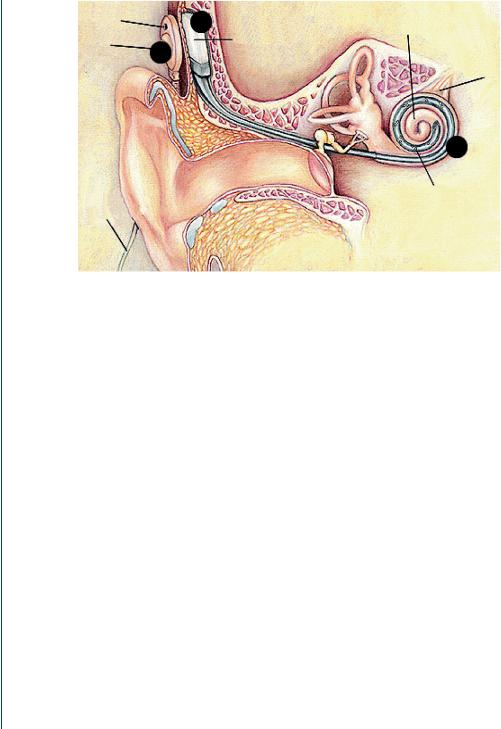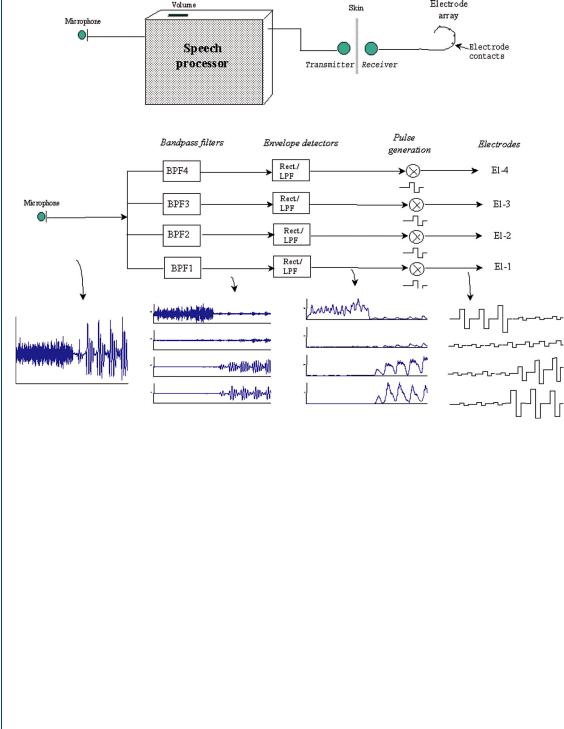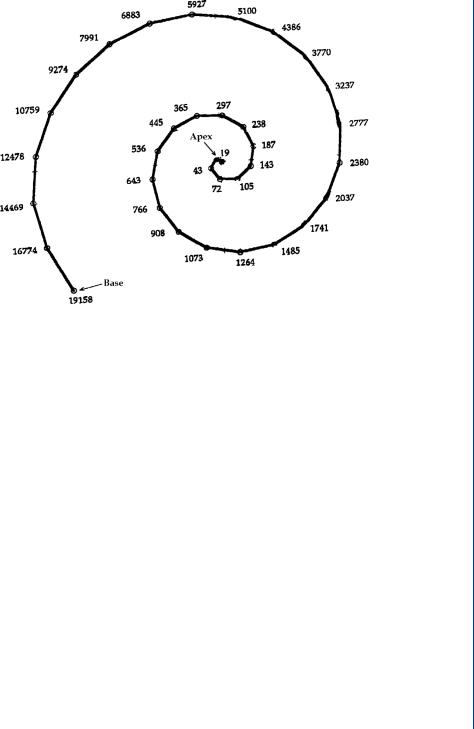
Sensory Organ Replacement and Repair - Gerald E. Miller
.pdf
26 SENSORY ORGAN REPLACEMENT AND REPAIR
Microphone
Headpiece
4 |
Implantable |
Cochlea |
3 |
cochlear |
|
stimulator |
Auditory |
nerve
5
Cable to |
Electrode array |
|
speech |
||
|
||
processor |
|
FIGURE 35: Cochlear implant components (see text for details).
the electrodes (Figure 35, point 5) in the cochlea, which stimulate the auditory nerves directly. Different parts of the nerve are stimulated according to the pitch of the sound waves. In response, the auditory nerve carries out its natural function and conducts nerve impulses to the brain. The brain receives the nerve impulses and interprets them as sound. This whole process takes place within a few milliseconds, corresponding to the time delay in the normally functioning ear.
The circuit is attached to a bundle of tiny wires that are inserted into the cochlea. At the end of the wires are as many as 24 electrodes that cover a distance of 25 mm along the length of the cochlea. Stimulation of each electrode usually causes a different pitch perception. A close-up view of the headpiece is shown in Figure 36, which indicates that the headpiece is often covered by the patient’s hair and thus it is not normally evident. This is done on purpose to avoid the stigma associated with this relatively new technology for a profoundly deaf individual. The reasons for such a stigma will be discussed below.
Sounds are picked up by the small, directional microphone located in the headset of the ear. The microphone picks up all sound from the environment whether it is speech, environmental sounds, or music. Unlike a hearing aid, a cochlear implant is routinely used for the profoundly deaf individual. Although processing of speech is important, the transmission of other sounds is often as important, unlike a hearing aid where speech amplification is often the primary goal. Many profoundly deaf individuals may have never heard music or environmental sounds if deaf from birth. Thus the overall processing of sound with a cochlear implant has a greater impact

COCHLEAR IMPLANT 27
FIGURE 36: Close-up view of the headpiece connected near the mastoid bone.
and a broader goal than that of a hearing aid. An excellent review of the basics of cochlear implants has been published by Loizou (1998).
Sound received by the microphone must be processed to determine how the electrodes should be activated. The simplest way of sound processing would be to divide the auditory signal by the number of electrodes in the implanted portion of the device and apply appropriate voltage(s) to the appropriate electrode(s). In actuality, sophisticated processing algorithms are used, since applying voltage to each of the electrodes at the same time would cause currents to flow between the electrodes, which would stimulate multiple nerves and thus produce multiple (unwanted) frequencies in the “heard” sound. Modern sound waveform processing strategies often utilize bandpass filters to divide the signal into different frequency bands. Algorithms are employed to select a number of the strongest outputs from the filters, which often emphasize transmission of the time-domain aspects of uttered speech. Specialized feature extraction strategies use vowels and formants to evaluate each spoken utterance, the latter being an expanded set of vowel-like sounds. Fricative sounds are an expanded set of consonants and are utilized to fine tune the vowel and formant coding to allow proper microprocessor recognition of a spoken word or utterance. Normally, it is the time-varying aspects of the spectral content of speech that are employed in such coding. An example of this time-varying spectral content is shown in Figure 4. Figure 37 depicts speech coding strategies and elements of a cochlear implant including bandpass filters, envelope detectors, pulse generators, and culminating in the stimulating electrodes for a four-channel system (Loizou, 1998). The waveforms at each stage of this speech coding process are also displayed in Figure 37. The sound is processed through a set of four bandpass filters that divide the acoustic waveform into the four channels. Current

28 SENSORY ORGAN REPLACEMENT AND REPAIR
FIGURE 37: Stages of the speech processor in a typical cochlear implant and the associated processing waveforms at each stage for a four-channel device (Loizou, 1998).
pulses are generated with amplitudes proportional to the energy of each channel, and transmitted to the four electrodes through a radio frequency link. Channel 1 represents the lowest of the frequencies and channel 4 the highest. The amplitudes of each of the current pulses delivered to each of the electrodes reflect the spectral content of the input signal, with each appropriate electrode receiving excitation relative to the other electrodes. As an example, if the speech signal mostly contains high-frequency information, then the pulse amplitude of the fourth channel will be larger relative to the pulse amplitudes of the other channels. Similarly, if the speech signal mostly contains low-frequency information, then the pulse amplitude of the first channel will be larger relative to the amplitudes of the higher channels. The electrodes are therefore stimulated according to the energy level of each frequency channel, in a manner similar to that one in the natural cochlea.

COCHLEAR IMPLANT 29
Fundamental elements of a cochlear implant include electrode design (number of electrodes and electrode configuration), method of stimulation (analog or digital), as well as the method of feature extraction signal processing, as noted above. The design of electrodes for a cochlear implant has been the focus of research for over many years since the inception of the device (Clark et al., 1983; Hochmair-Desoyer et al., 1983). Early designs incorporated single electrodes in order to test the concept of a cochlear implant, such as that by Tyler (1998), with the number of electrodes employed rising with advances in the science and technology associated with cochlear implants. Modern versions employ 16, 24, or 32 electrodes. Issues associated with electrodes include electrode placement, number of electrodes, spacing of contacts, and orientation of electrodes with respect to the excitable tissue. A larger number of electrodes would provide better reproduction of sound to the brain, while a smaller number of electrodes would provide a more artificially sounding reproduction. However, more electrodes might introduce cross talk within the cochlea as closely spaced electrodes might produce excitation in neighboring tissue (below another electrode), even if that neighboring electrode did not fire. One issue is the sliding of the electrode set along the cochlea to rest at the appropriate place, with, as an example, the electrode representing the band 800–900 Hz being at the proper place in the cochlea where that would represent the same frequencies. This is both a surgery issue and a signal processing issue. It is vital that the electrodes are placed in close proximity with corresponding auditory neurons that lie along the length of the cochlea, or the entire sound spectrum will be shifted in frequency as “heard” by the brain. In most cases, the electrode arrays can be inserted in the scala tympani to depths of 22–30 mm within the cochlea.
The method of frequency encoding and electrode stimulation is constrained by the number of surviving auditory neurons that can be stimulated in the cochlea. It would be ideal to have surviving auditory neurons lying along the length of the cochlea, which would support a good frequency representation through the use of multiple electrodes, with each stimulating a different site in the cochlea as is done in a normal human ear. If the number of surviving auditory neurons is restricted to a small area in the cochlea, then the number of electrodes and frequency pattern is limited by pathophysiology. In that situation, only a few electrodes are needed near the surviving area of the cochlea. As such, it is important to have electrode design and numbers along with firing pattern and stimulation linked to the pathophysiology of the cochlea. It is pointless to use electrodes where there is no chance of providing neural response. Therefore, using a large number of electrodes will not necessarily result in better performance, because frequency coding and electrode stimulation are constrained by the number of surviving auditory neurons that can be stimulated.
In addition, electrode stimulation is constrained by the spread of excitation caused by standard electrical stimulation of tissue. When electric current is injected into tissue such as the cochlea, it tends to spread out symmetrically from the source. This is the basis for the

30 SENSORY ORGAN REPLACEMENT AND REPAIR
FIGURE 38: Monopolar and bipolar configurations of cochlear implant electrodes (Loizou, 1998).
electrocardiogram, as an example. As a result, the current stimulus in the cochlea does not stimulate just a single auditory neuron, but several. Such a spread in excitation is more prominent in a monopolar type of electrode configuration. In such a configuration, the active electrode is located far from a reference electrode, which acts as a ground for all electrodes in a multiple electrode configuration. The spread of excitation can be controlled to a degree by using a bipolar electrode configuration. In the bipolar configuration, the active and the reference (ground) electrodes are placed in close proximity to each other. Various studies have shown that bipolar electrodes produce a more localized stimulation than monopolar electrodes, such as Merzenich and White (1977) and van den Honert and Stypulkowski (1987), among others. Figure 38 depicts both types of electrodes.
There are generally two types of stimulation depending on how information is presented to the electrodes: analog or digital. In analog stimulation, an electrical analog of the acoustic waveform itself is presented to the electrode. As an example, in multichannel implants, the acoustic waveform is bandpass filtered, and the filtered waveforms are presented to the appropriate electrodes simultaneously in analog form. An advantage of analog signal processing is that the electronics are usually simpler and cheaper. A disadvantage of analog signal processing is that the simultaneous stimulation may result in cross talk. In digital signal processing, the

COCHLEAR IMPLANT 31
information is delivered to the electrodes using a set of pulses. In some approaches, the timing and amplitude of these pulses are obtained from the envelopes of the filtered waveforms, as is shown in Figure 37. The advantage of this type of signal processing is that the pulses can be delivered in a nonoverlapping approach, thereby minimizing cross talk. The rate at which these pulses are delivered to the electrodes has been found to affect speech recognition performance (Wilson et al., 1995). High pulse rates tend to yield better performance than low pulse rates. Pulse rates as low as 100 pulses per second and as high as 2500 pulses per second have been used. Wilson et al. reported that some patients obtained a maximum performance with a pulse rate of 833 pulses per second and a pulse duration of 33 ms, while other patients obtained significant increases in performance as the pulse rate increased from 833 to 1365 pulses per second, and from 1365 to 2525 pulses per second, again using 33-ms pulses (Wilson et al., 1995). It is apparent that an optimal pulse rate depends on a particular patient, but that the pulse width is dependent on the tissue sustaining the electrical excitation. A digital representation of the speech signal often results in a more accurate representation, but the technique may be more expensive. Modern cochlear implants employ digital signal processing techniques for multiple electrode configurations. Another benefit of the digital technique is that the digital pulse stimulation order (to the various electrodes) can be varied to minimize possible cross talk between channels. Electrodes can be sequentially excited (in a rapid fashion), randomly excited, or excited in groups with the spacing far enough apart to minimize cross talk. As with the pulse rate, the optimal electrode firing pattern may vary from patient to patient.
Currently, some implant devices employ monopolar electrodes, while some devices employ bipolar electrodes, and there are other devices that employ both types of electrodes. Loizou reported that the Symbion cochlear implant used six electrodes spaced 4 mm apart in their bipolar configuration with only the four most apical electrodes used in the monopolar configuration (Loizou, 1998). The Nucleus cochlear implant used 22 electrodes spaced 0.75 mm apart for the monopolar configuration with electrodes that were 1.5 mm apart used as bipolar pairs. The Clarion cochlear implant used both monopolar and bipolar configurations. Eight electrodes spaced 2 mm apart were used. The Med-El cochlear implant used eight electrodes spaced 2.8 mm apart in a monopolar configuration. Further details regarding the electronics and signal processing elements in various cochlear implants have been reported by Loizou (1998).
3.3Current Devices and Cochlear Implant Companies
In 2005, the top three cochlear implant devices were manufactured by Cochlear Corporation (Australia), Advanced Bionics (United States), and MED-EL (Austria). These are similar devices. Each manufacturer has adapted some of the successful innovations of the other companies to their own devices. There is no clear-cut consensus that any one of these implants is superior to the others. Users of all three devices display a wide range of performance after implantation.

32 SENSORY ORGAN REPLACEMENT AND REPAIR
Of the three companies, Cochlear Corporation has the longest history in cochlear implantation and the high reliability of their devices has been demonstrated over three decades, as the cochlear implant is generally known to have originated in Australia. Advanced Bionics has been noted to have more advanced electronics, resulting in the more advanced speech processing capabilities. MED-EL has the longest electrode array of the three companies, enabling insertion into the deepest part of the cochlea.
Since the devices have a similar range of outcomes, other criteria are often considered when choosing a cochlear implant: usability of external components, cosmetic factors, battery life, reliability of the internal and external components, customer service from the manufacturer, the familiarity of the user’s surgeon and audiologist with the particular device, and anatomical concerns.
There is a great variability in the speech recognition performance of cochlear implants as reported by patients, technicians, and physicians. For a given type of implant, auditory performance (in terms of word or utterance recognition) may vary from zero to nearly 100% correct. The factors responsible for successful word/utterance recognition have been the focus of research for many years. Some of the factors that have been found to affect auditory performance are listed below:
1.Outside factors: These include duration of deafness, age at implantation, and residual hearing, as well as issues that are beyond our control. There is a huge variance in how well people do with implants, largely due to the wide degree of differences of these factors. Those with residual hearing respond better to cochlear implants and require less training. Those patients who are deaf from birth require more training and have a checkered success rate. Younger patients do better than older patients who have been deaf for longer periods. Very young patients, who have not yet formulated language, respond better. A discussion of cochlear implants in the very young patients is noted below as are factors associated with the deaf community response to cochlear implant usage.
2.Attitude and determination: The amount of work and practice that the patient puts into making it work is very important to making the most of the implant. Cochlear implant recipients normally receive speech and/or auditory therapy to make the most of their implants. The implant is not a miracle cure for deafness, since the number of channels is far less than the number of frequency excitations in the natural ear. Many profoundly deaf (or deaf from birth) patients find it frustrating and discouraging to undergo the long and difficult process of learning to hear with the implant.
3.Skill of audiologist and surgeon: A good surgeon and audiologist can help ensure that recipients get the most that the implant has to offer. One should determine how much

COCHLEAR IMPLANT 33
experience the audiologist and the surgeon have with implants, and get a sense for how dedicated they may be to help you in the years to come with any challenges that arise.
4.Type of device: Newer generations of cochlear implants have improved the chances that people will hear well with them, with digital signal processing techniques, improved electrode design, improved support electronics, and improved surgical techniques.
3.4Issues Associated with Implant Use
As was noted above, there have been issues raised regarding the use of cochlear implants, which has limited its implantation in a large number of patients. For the elderly patient, the risk of surgery in the older patient must be weighed against the improvement in quality of life. As the devices improve, particularly the sound processor hardware and software, the benefit is judged to be worth the surgical risk particularly for the newly deaf elderly patient (Waltzman et al., 1993).
The use of cochlear implants is objected to by some, particularly in the deaf signing community (people who use sign language to communicate). Many members do not view deafness as a disability that has to be “fixed” by cochlear implants, but rather just a different way of living. Cochlear implants for children work best when implanted at a young age, when the brain is still learning to interpret sound, and hence are implanted before the recipients can decide for themselves. There is a debate about the age that would be the best or safest for children to receive cochlear implants. However, as cochlear implants have improved and proven themselves to work well, the objections are getting less tenable. Proponents of cochlear implants believe that, since mammals are meant to have a hearing sense, deafness is a disability to be corrected. To them, objecting to a cochlear implant is akin to objecting to a heart transplant, prosthetic arm, or glasses.
Opponents of cochlear implants often compare implantation to cultural genocide, as the common ground for the signing community is deafness, either through personal experience or by personal relationships with others who have hearing impairments. Opponents of implantation tend to object not to the medical benefits of implantation, but to the perceived loss of the sense of community that has defined deaf history. Statistics show that the majority of deaf infants are born into hearing families. For such children becoming a member of the deaf community is not automatic, nor is it initially a decision for them to make; rather it is a choice made by their parents, in what they perceive to be the children’s best interests, as they understand them. In 2000, an academy-award-nominated film Sound and Fury depicted this cultural divide. In addition, the implantation of cochlear implants in very young children has become a topic of much consternation in the deaf community and has spawned Web sites such as www.cochlearwar.com and www.ragged-edge-mag.com, both have numerous citations and editorials opposing the

34 SENSORY ORGAN REPLACEMENT AND REPAIR
implantation of cochlear implants in small children. Of all artificial organs and all sensory assist or replacement devices, the use of cochlear implants has created the largest amount of controversy and vitriol. This is primarily due to the strongly cohesive nature of the deaf community that does not feel that deafness is a disability like paraplegia or blindness, and thus does not necessitate the use of a cochlear implant. Although there is less controversy with the implantation of cochlear implants in adults, there is still not widespread support for such implantation, which has reduced the number of individuals seeking an alternative to profound deafness. Opponents of cochlear implants cite the prevalence of acquired meningitis as a result of implantation surgery. However, data from the FDA and the Center for Disease Control (CDC) indicates that the prevalence of meningitis for the general population varies from 1 in 10 000–15 000 and for those with cochlear implants, it is 1 in 9000–13 000. There is thus statistically no significant difference. However, the data for the general population utilize a far greater sample size than that for the cochlear implant patient data.
3.5History of the Cochlear Implant
Professor Graeme Clark of the University of Melbourne is generally credited as the creator and developer of the world’s first multichannel implant and is considered by many to be the father of the cochlear implant. In 1967, Professor Clark began researching the possibilities of an electronic implantable hearing device. His endeavor would eventually lead to the creation of the implantable “bionic ear.” Inspired by his close relationship with his father, who had been deaf throughout his life, Professor Clark’s goal was to find a way to improve hearing, and the quality of life for people who are deaf. Professor Clark has been the Research Leader at the Department of Otolaryngology at the University of Melbourne since 1970. His first cochlear implant surgery took place in 1978. In 1979, Nucleus, a group of medical equipment manufacturers, became interested in the commercial potential of Professor Clark’s work at the University of Melbourne. Two years later, the University of Melbourne, the Australian Government, and Nucleus set out to develop a commercially viable cochlear implant, and to bring it to market through a worldwide clinical trial. Cochlear Ltd. was established in 1982, as a corporate entity in order to continue commercial operations. Professor Clark is the Director of The Bionic Ear Institute in Melbourne (Australia), which was established in 1984 to support and undertake research to better understand deafness and improve the “bionic ear.”
The basis for the cochlear implant is predicated on the spatial frequency representation of the cochlea, which was first elucidated by the pioneering work of Georg von Bekesy in the 1950s, which showed that the basilar membrane in the inner ear is responsible for analyzing the input signal into different frequencies (Hachmeister, 2003; Shampo and Kyle, 1993). Different frequencies cause maximum vibration amplitude at different points along the basilar membrane. A famous diagram of this spatial frequency representation is shown in Figure 39.

COCHLEAR IMPLANT 35
FIGURE 39: Spatial variation by frequency in the human cochlea, first represented by von Bekesley.
3.6Regulatory Issues for Cochlear Implants and Recent Research
For a relatively new technology such as a cochlear implant with few implants compared to the entire deaf population, the issues regarding regulatory controls for cochlear implants are of paramount importance. This is very evident when one looks at the FDA Web site at www.fda.gov and then to its medical devices section, where cochlear implants are one of the key topics on the right (as of January 2006). The FDA has a primer on the topic complete with movies. From 1984 through 2001, there were seven different applications approved for cochlear implants including the following:
Cochlear Corp |
1984 |
3M Brand |
Cochlear Americas |
1985 |
Nucleus Mutichannel |
Cochlear Americas |
1990 |
Nucleus 22 Channel |
Advanced Bionics |
1996 |
Clarion Multistrategy |
Advanced Bionics |
1997 |
Clarion Multistrategy |
Cochlear Americas |
1998 |
Nucleus 24 |
Med-El Corp |
2001 |
Combi 40+ |
The Web site listing these approved applications is at http://www.accessdata.fda.gov/ scripts/cdrh/devicesatfda/index.cfm, which also notes any warning letters, MedWatch reports,
